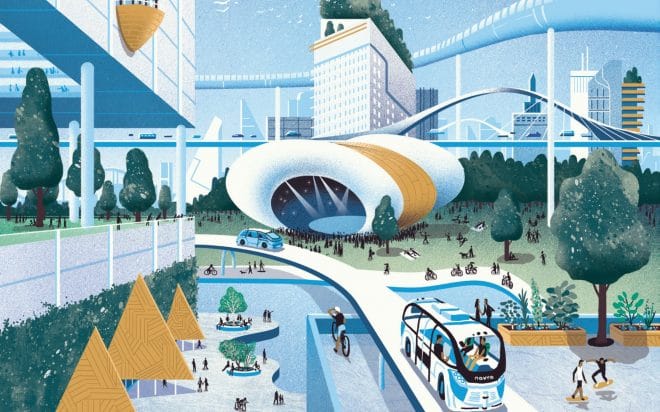
Half of the world’s population lived in cities in 2008: by 2050, the percentage of urban dwellers in the world will rise to 70%. In all cities, the energy demand will be multiplied by two, even though we must reduce CO2 emissions today to slow global warming. As they are and will be growing and meet new challenges, our cities will undoubtedly transform and become smarter. The stakes of this profound change are very diverse, and they concern all categories of population and all sectors.
Understand the citizens’ needs to model each city
Even if each metropolis faces different needs and thrives in a proper context, all the cities evolve with the same objective of becoming “smarter”: collect a maximum of data about the lifestyle of the inhabitants, analyze them and set up the infrastructures that best meet their needs.
Logically, even if the priorities vary from one agglomeration to another, a similar approach will be considered to adopt smart urban planning policies. Indeed, the smart city must first be open on the citizens, develop thanks to their active contribution such as debates and consultations.
More generally, the smart city will optimize the living conditions of all its residents, regardless of their standard of living. Its model aims at the social inclusion of every citizen, but also the financial stability and the control of the ecological impact. It will also have to deal with new risks and participate in the fight against phenomena such as hacking and personal data breaches.
In London, for example, the smart-city is built in collaboration with all citizens: thanks to the platform “Talk London”, everyone has access to the useful information to live simply on the spot (circulate, work, services access). Of course, this device has been designed so that everyone can share their opinion and participate in various polls. In this way, urban development takes into account the real needs of everyone, as in the case of these exchanges and measures to improve accessibility of public transport.
Transport: how to develop smart and eco-responsible mobility?
In a world in which one feels closer and closer to distant destinations (thanks to the Internet, but also with the development of high-speed lines that shorten journeys), cities have understood that the point is not to reduce circulations. Our cities need mobility to thrive. On the other hand, in order to simplify the users’ lives and reduce the carbon footprint, it is essential to review all the transport infrastructures, optimize the functioning of the solution network, for a perfect integration of mobility within the smart-city.
In terms of travels, the smart city must introduce solutions that are accessible to the greatest number (cheap or even free), which consume little energy, do not pollute and does not disturb the traffic.
Some cities even make very radical decisions, like Guanhzhou in China: there, all trips can be made on foot. The entire territory was designed so that pedestrians and cyclists can easily access all services (schools, administrations), go to work or do their shopping. In these metropolises oriented towards soft mobility, the use of the car is reduced to a minimum!
Technologies supporting transport infrastructures
The cities will necessarily have to connect more and more devices to each other (buses, trams, cars, bicycles, shuttles, subways, etc.) to adjust the supply of transport to the demand, but also in order to inform all users in the best possible way.
Optimization of real-time data collection will make it easier to anticipate traffic jams while providing everyone with the information they need to move around easily.
The challenge of multimodality
The smart city has to deal with an ever-increasing population and fundamentally different lifestyles, it cannot offer only one or two modes of transport. The smart city will undoubtedly be multimodal.
On the issues of mobility, the city of Singapore is very ambitious. To reduce the use of cars as much as possible, the city did not hesitate to introduce free public transport in certain slots, and at the same time, to set up various autonomous shuttles as well as sharing electric vehicles.

Ecology encouraged by innovation
For example, “free-floating” has developed a lot in Vancouver (Canada) and should soon join other cities such as Seattle and San Diego, among others. This concept was initiated by the car manufacturer Daimler and its service “Car2go”, it allows carsharing without parking the vehicle on a dedicated place. Vehicles can be dropped off or picked up anywhere, simplifying access to service – while still maintaining a certain fluidity on city traffic.
Into smart cities, the development of modes of alternative transports is already a priority. That is to say, the main goals are to avoid the individual automobile and to adapt to the needs of the citizens. Everywhere in the world, our cities are progressing and designing urban models focused on soft traveling: in some large cities where the car still dominates, intelligence and creativity will be essential to meet the “smart city” challenge.


